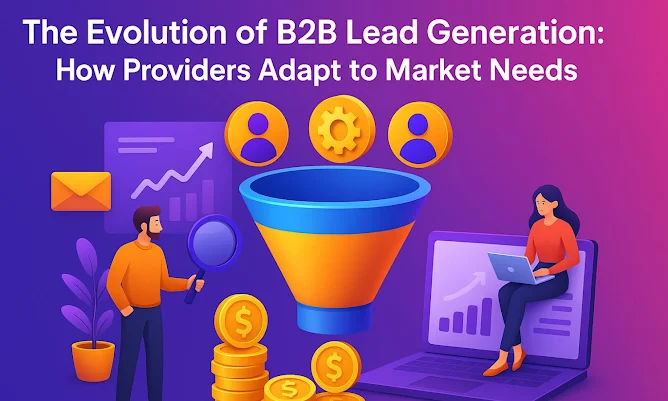The approach to B2B lead generation has significantly changed in recent years. From the early days of manual outreach to the current reliance on digital tools and data, businesses have shifted how they connect with potential clients. This shift is influenced by changes in buyer behavior, growing expectations for personalization, and the increasing role of data in decision-making. Understanding how lead generation has evolved helps businesses stay in sync with current practices and expectations.
Traditional B2B Lead Generation Methods
B2B lead generation originally depended on direct contact methods. Businesses used offline strategies to reach prospects and convert them into clients.Common Traditional Methods:
- Cold calling decision-makers
- Sending bulk email campaigns
- Attending trade shows and events
- Using purchased contact lists
These approaches had their place, but they were often limited in reach, lacked precision, and did not provide enough data to measure effectiveness. As technology advanced, the limitations of these practices became more evident.
The Shift Toward Digital and Inbound Strategies
Modern lead generation favors attraction-based techniques. Businesses create content and digital experiences that encourage prospects to engage with them.Key Elements of Inbound Lead Generation:
- Search engine optimization (SEO)
- Blogs, whitepapers, and educational content
- Social media presence
- Landing pages with lead capture forms
These methods meet potential buyers where they are online, making the process more organic and data-informed. Inbound lead generation also helps businesses build long-term interest by focusing on providing useful content and solutions.
Data-Driven Lead Generation: Smarter Targeting
Data is central to today’s lead generation strategies. Providers no longer rely on static lists. They use real-time data and insights to identify potential leads that fit specific business needs.Benefits of Data-Driven Approaches:
- Improved targeting accuracy
- Higher quality of leads
- Better lead nurturing opportunities
Providers now use data points like company size, industry, buyer intent signals, and past behavior to deliver highly relevant leads. These strategies help reduce guesswork and enable focused marketing efforts.
Adapting to Buyer Behavior and Market Shifts
The way buyers interact with businesses has changed. Most decision-makers conduct online research before speaking to a sales team. As a result, businesses must be prepared to provide value early in the buying process.Notable Shifts in Buyer Behavior:
- Preference for self-education through online content
- Expectation for immediate and personalized communication
- Greater skepticism toward cold outreach
These shifts require providers to move from volume-based models to approaches that focus on relevance and timing. Account-based marketing has grown in popularity for its ability to engage specific business segments more meaningfully.
How Lead Providers Are Evolving
Lead generation providers now focus on delivering quality over quantity. This evolution is marked by the use of advanced technologies and more strategic roles in client campaigns.Key Adaptations:
- Use of predictive analytics to prioritize leads
- Real-time data verification
- Providing segmented, verified leads based on firmographics
- Developing custom databases by industry
These improvements make the data more actionable and reduce the friction in the sales process.
Role of Compliance and Data Security
With the rise of data privacy laws, providers are required to operate within strict compliance frameworks. Businesses that rely on third-party leads must ensure those leads are sourced ethically and legally.Important Compliance Standards:
- General Data Protection Regulation (GDPR)
- California Consumer Privacy Act (CCPA)
- Opt-in and consent-based data collection practices
Providers that follow these standards offer more reliability and help businesses avoid legal risks. This focus on transparency has become a core part of modern lead generation.
The Future of B2B Lead Generation
The future of B2B lead generation will continue to be shaped by innovation and changing buyer expectations. Businesses and providers will need to work together to respond to new challenges.Emerging Trends:
- Greater use of artificial intelligence for lead scoring
- More use of chatbots and automation for first contact
- Rise of omnichannel strategies combining email, social media, and direct messaging
- Growing reliance on predictive data and real-time intent monitoring
Providers that invest in these capabilities will stay more aligned with business needs in the long run.
What to Look for in a Modern Lead Generation Provider
Choosing the right provider involves assessing more than just the number of leads they deliver. Businesses should evaluate how well the provider understands their target market and how they ensure data quality.Questions to Ask When Evaluating a Provider:
- Do they use real-time data verification?
- Can they provide leads that meet specific criteria?
- How do they ensure compliance with data protection laws?
- What methods do they use to measure lead quality?
A reliable provider should be transparent about their processes and willing to adapt to your needs without compromising compliance or accuracy.


Comments
Post a Comment